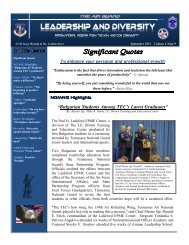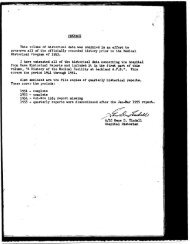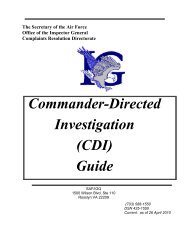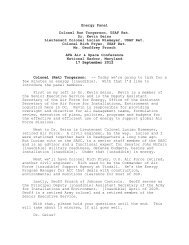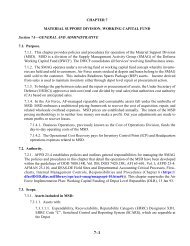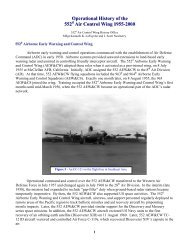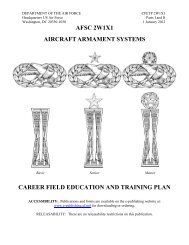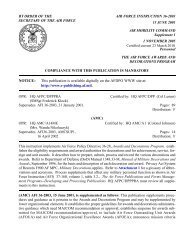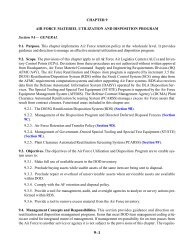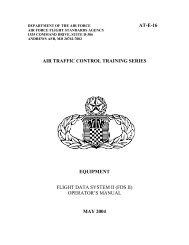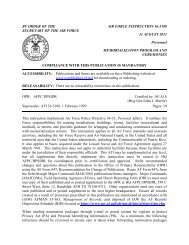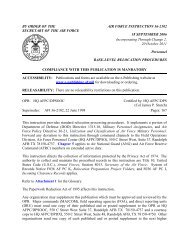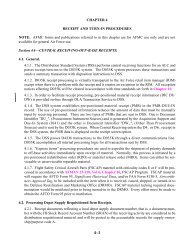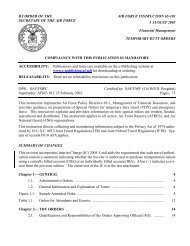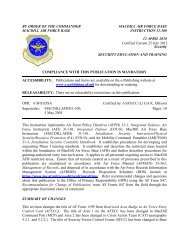CONTRAILS FACTS - Air Force Link
CONTRAILS FACTS - Air Force Link
CONTRAILS FACTS - Air Force Link
- TAGS
- contrails
- link
- www.af.mil
Create successful ePaper yourself
Turn your PDF publications into a flip-book with our unique Google optimized e-Paper software.
A different type of contrail or condensation trail is caused when a wing surface or winglet causes<br />
a cavitation of air in very humid conditions. This results in a unique vapor trail that is not formed<br />
due to exhaust gases. The next time you fly in a commercial aircraft through a rain cloud, look<br />
for the vapor trails that form over and around the wing. Typical fighter wingtip contrails are<br />
shown below.<br />
Exhaust Gases and Emissions<br />
Often, military aircraft can be seen taking off with a black smoke appearing from the engines.<br />
This smoke is mainly soot particles, similar to diesel engines. Commercial aircraft also produce<br />
the same type of soot particles, but usually not to the same degree as military aircraft. This is for<br />
two reasons: the type of fuel and the type of engines.<br />
Most military aircraft use JP-8 jet fuel which is a blend of commercial Jet Aviation Fuel -1 (or Jet<br />
A-1) with three extra additives. The additives are used to control ice formation, control biogrowth<br />
(molds and slimes), and inhibit corrosion. The military uses these additives because of the<br />
unique environments the military operates in, the type of self-sealing fuel tanks used, and the<br />
type of metals, plastics, and sealant used on military aircraft. Several specialized aircraft like the<br />
SR-71 and U-2 use different fuels than JP-8, but are developed from the same base stock.<br />
Fuels research is always ongoing. The newest fuel being brought into production is JP-8+100.<br />
Dubbed JP-8+100 because the additive package can increase the thermal stability of military<br />
fuel by 100 degrees Fahrenheit, the improved fuel helps prevent gums and deposits that can<br />
foul fuel lines.<br />
Military engines are also designed with different performance characteristics than commercial<br />
aircraft. Military aircraft and engines also tend to be older and less efficient than commercial<br />
aircraft and produce more emissions. Engines are optimized for fuel consumption and power<br />
rates at a particular cruising altitude. At take-off, the engines are usually very inefficient and<br />
produce more emissions than when at the optimal cruising altitude. Older military aircraft like the<br />
B-52 and C-130 can leave a black smoke exhaust even at cruising altitude, while aircraft like the<br />
KC-135R with new engines produce an invisible exhaust plume. Typical pictures of aircraft<br />
exhaust emission are shown below.<br />
Space launch vehicles and missiles produce a different type of exhaust than aircraft. The<br />
propulsion system on military rockets and missiles is usually made of solid rocket fuel. Missiles<br />
and rockets produce smoke plumes as a result of the solid fuel burning. The hot gases escaping<br />
from the motor can also create contrails, but the smoke and contrail combine to form a single<br />
exhaust plume. For more information on <strong>Air</strong> <strong>Force</strong> propulsion and fuels programs, see the <strong>Air</strong><br />
<strong>Force</strong> Research Laboratory Propulsion Directorate at http://www.pr.afrl.af.mil/.



